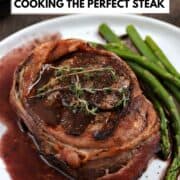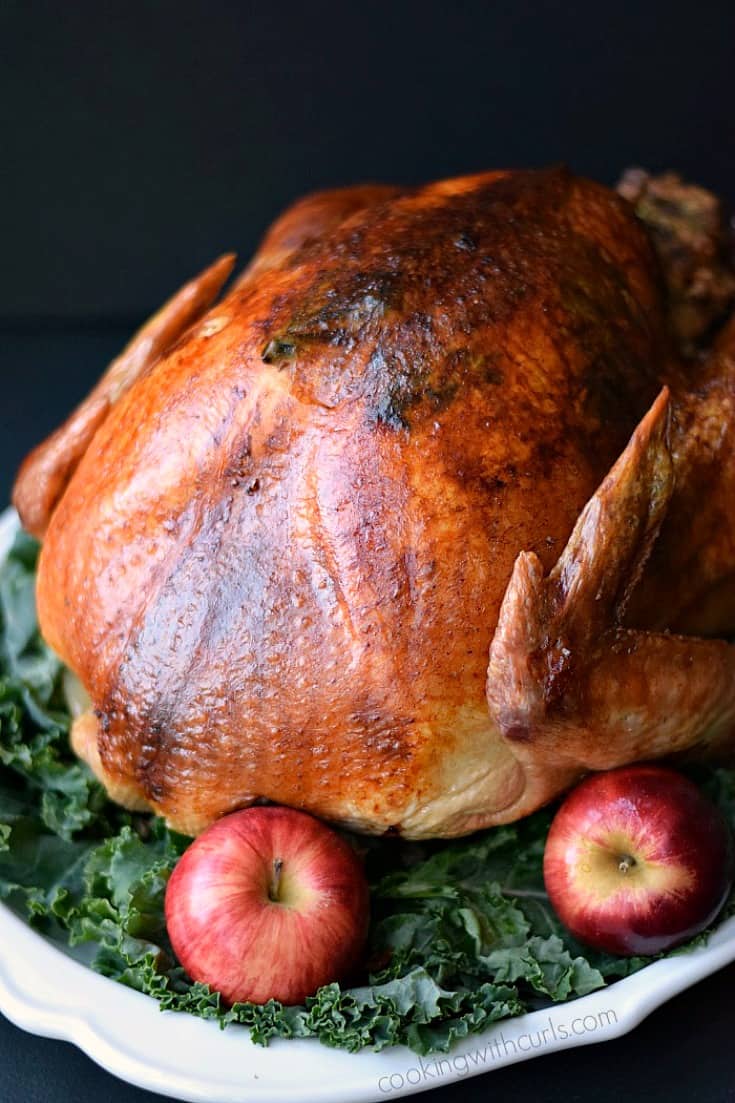The Ultimate Guide to Cooking the Perfect Steak
This post may contain affiliate links. As an Amazon Associate I earn from qualifying purchases. For more information, please visit my disclosure page.
Welcome to the Ultimate Guide to Cooking the Perfect Steak! Who doesn’t love a perfectly cooked steak? The popularity of steak for romantic dinners or fine dining can be seen around the world, and is a popular choice for those seeking a hearty and satisfying meal.
We will cover everything from choosing the right cuts of steak to mastering the art of cooking it to your desired level of doneness with methods like searing, grilling, and sous vide.
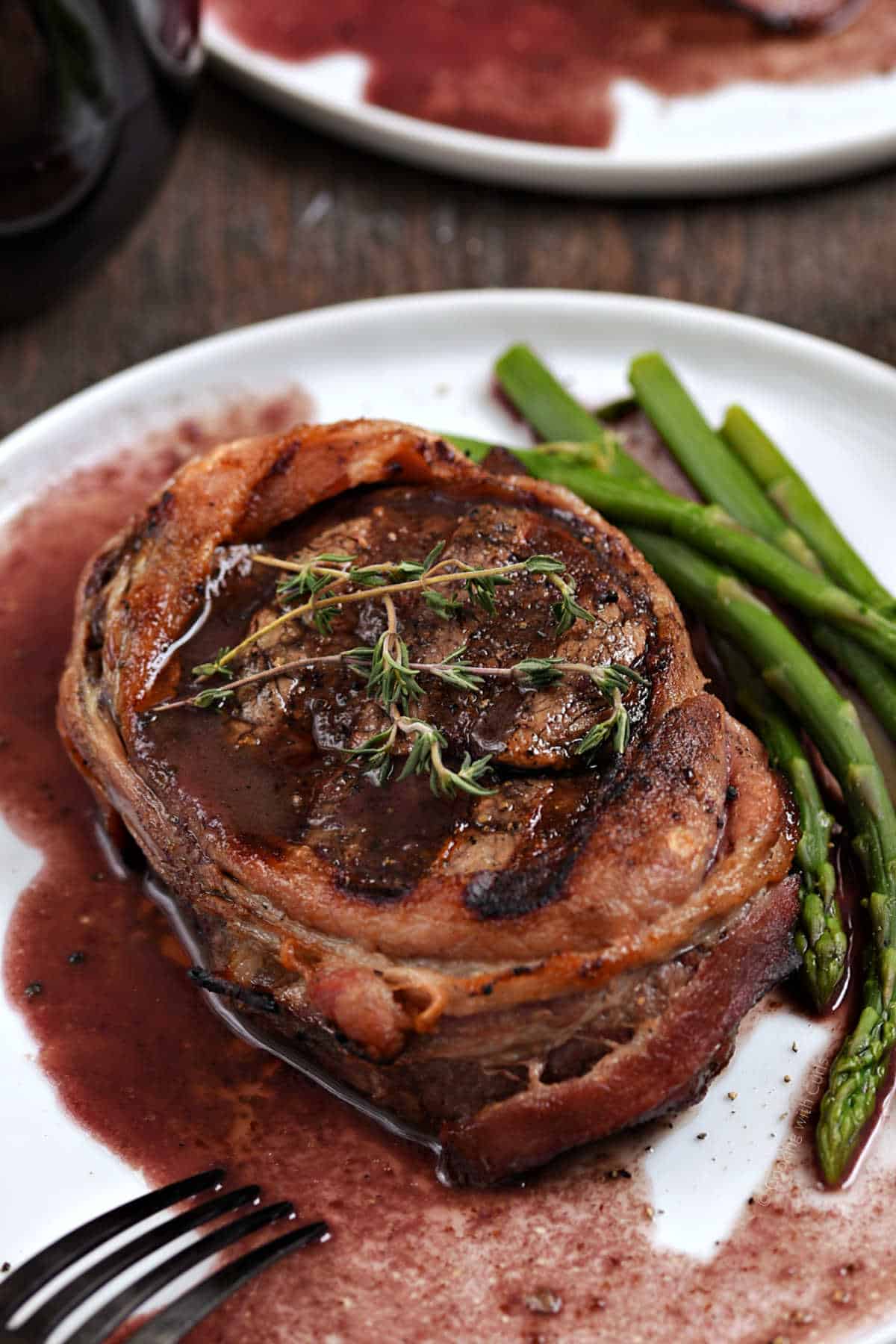
The grilled Bacon Wrapped Filet Mignon with a simple red wine sauce is one of my favorite restaurant meals that you can make at home.
Choosing the Right Cut of Steak
Understanding the various cuts of steak is crucial when it comes to achieving that perfectly cooked steak. Marbling, tenderness, and thickness play a significant role in determining which cut is best suited for your preferences and cooking style.
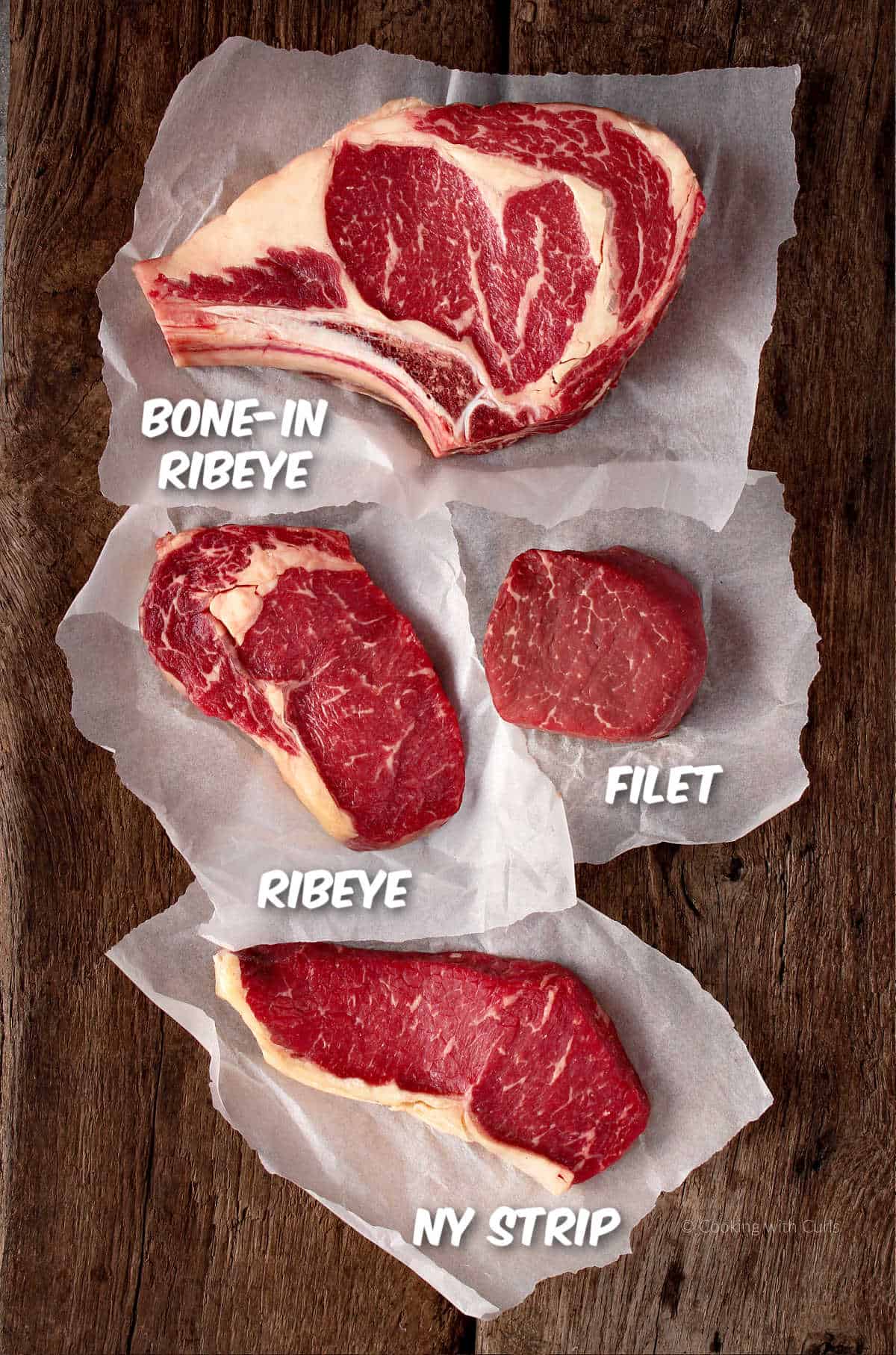
Are you ready to dive in and see how each factor impacts your choice? Get comfortable, grab a glass of wine – or not. Let’s do this!
What to Consider When Selecting a Cut of Meat
When selecting a cut of steak, consider the marbling, which refers to the white streaks of fat within the muscle tissue. More marbling generally means a juicier and more flavorful steak.
For those who prefer a tender cut, look for steaks with a higher marbling content, such as pan-seared ribeye steak or New York strip steak.

Tenderness is another important factor to keep in mind. Certain cuts, like filet mignon, my absolute favorite, are known for their exceptional tenderness due to containing less connective tissue. Thicker cuts, such as porterhouse steaks, can also provide a juicy and tender texture when cooked correctly.
The thickness of the steak factors into the cooking method. Thicker cuts are ideal for grilling or pan-searing to achieve a nice sear on the outside while keeping the inside juicy and tender. Thinner cuts, like skirt or flank steak, are better suited for quick cooking methods like broiling or stir-frying.
That’s not to say that you cannot grill a skirt steak to make carne asada tacos and nachos, you just need to keep a close eye on it to prevent overcooking.
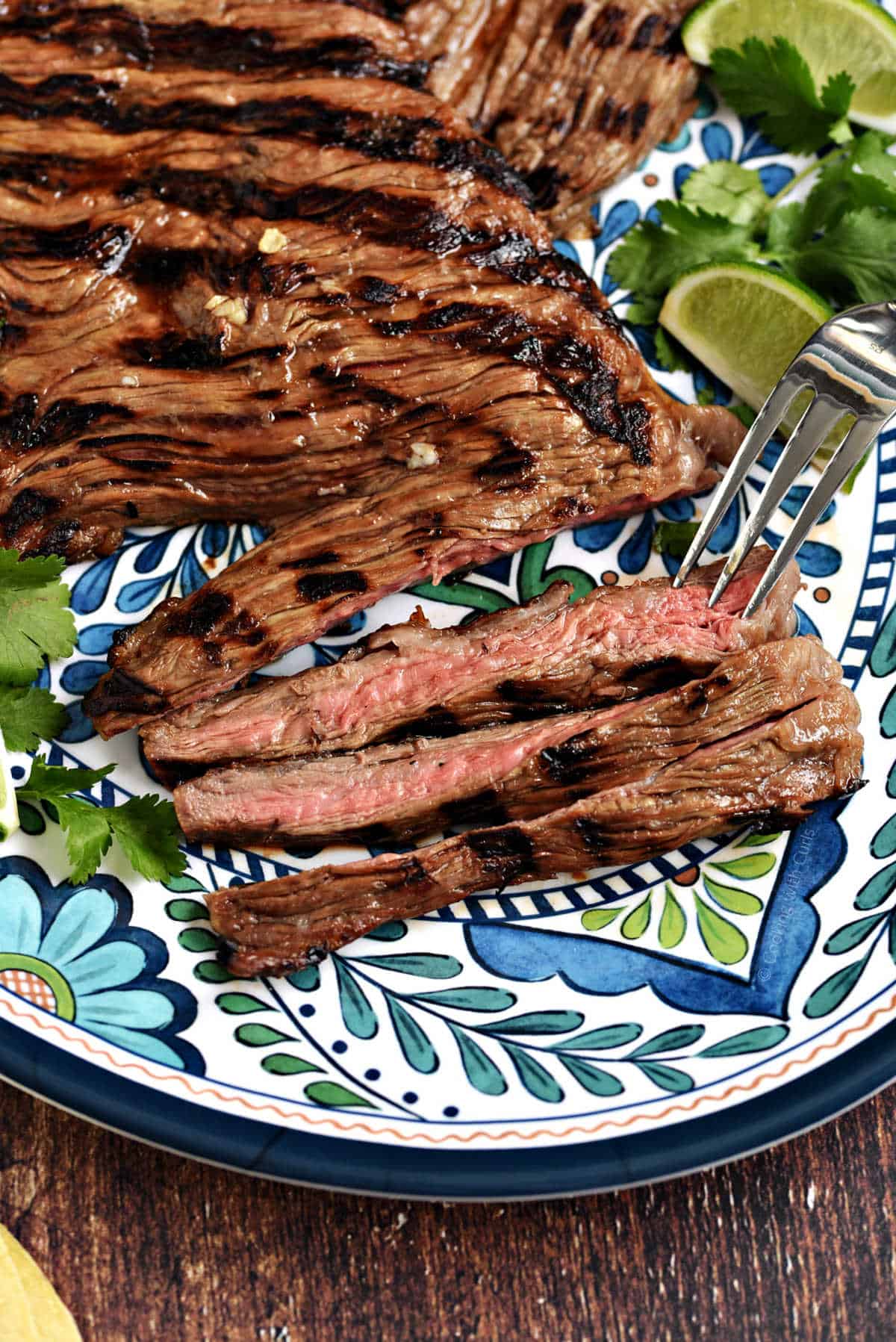
Matching the cut of steak to the cooking technique is essential for bringing out the best flavors and textures. Ribeye steaks are perfect for grilling, as the fat content enhances the smoky charred flavor. Filet mignon, on the other hand, is well-suited for pan-searing to lock in juices and create a crusty sear.
Perfect grilled ribeye steaks topped with heart-shaped herb butter are easy to prepare and look impressive.
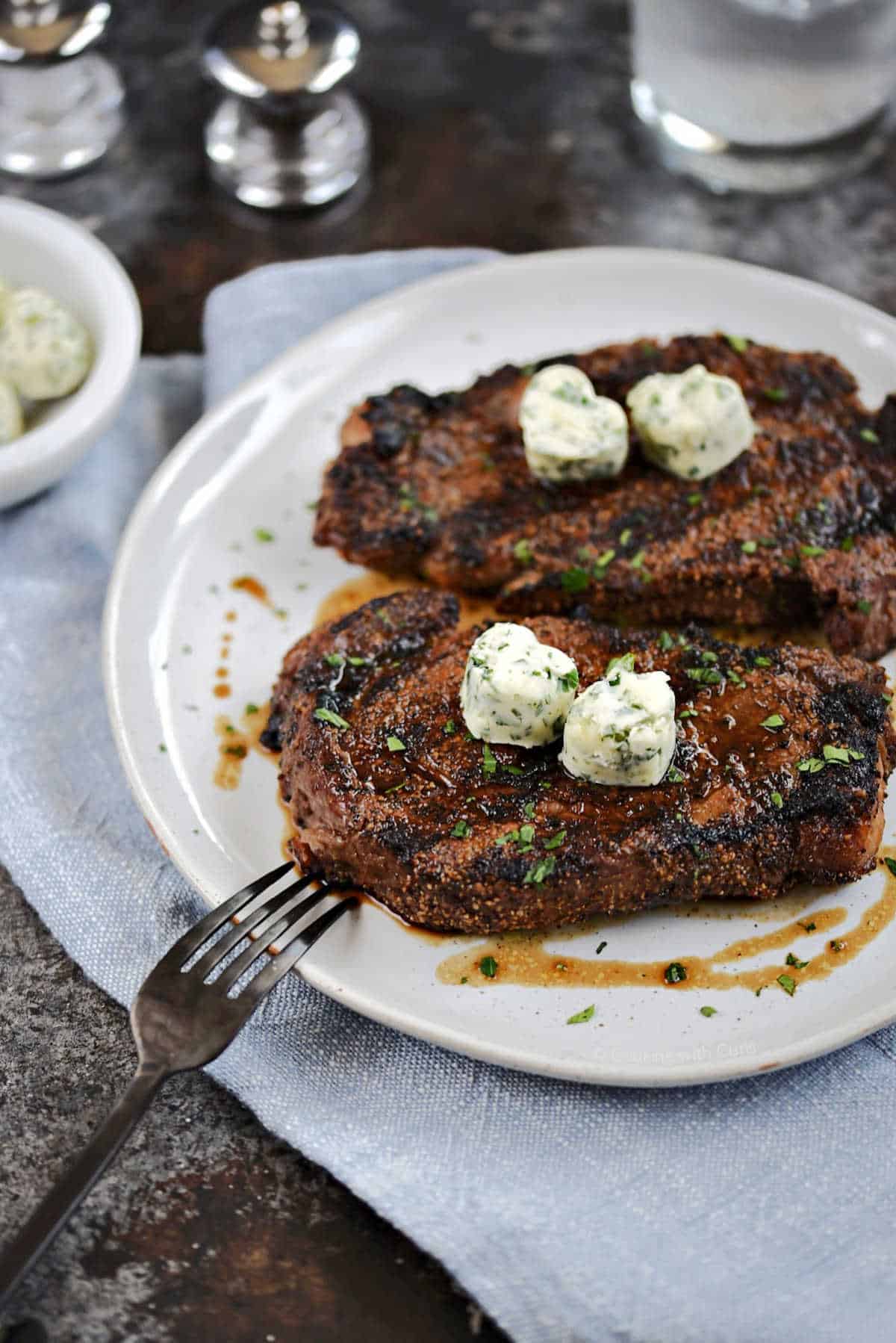
By understanding how marbling, tenderness, and thickness influence the selection of steak cuts, you can tailor your choice to suit your preferences and cooking methods.
Steak Descriptions
Filet Mignon:
- Description: Filet mignon is a tender and lean steak cut from the tenderloin of the cow. It’s known for its buttery texture and mild flavor.
- Characteristics: Filet mignon is exceptionally tender due to its low-fat content and lack of connective tissue. It’s usually smaller in size compared to other cuts but prized for its tenderness.

Ribeye:
- Description: Ribeye steak comes from the rib section of the cow, specifically from the rib primal. It’s well-marbled with fat, resulting in rich flavor and juiciness.
- Characteristics: Ribeye is known for its intense marbling, which adds flavor and juiciness to the meat. It has a good balance of tenderness and flavor, making it a popular choice among steak lovers.
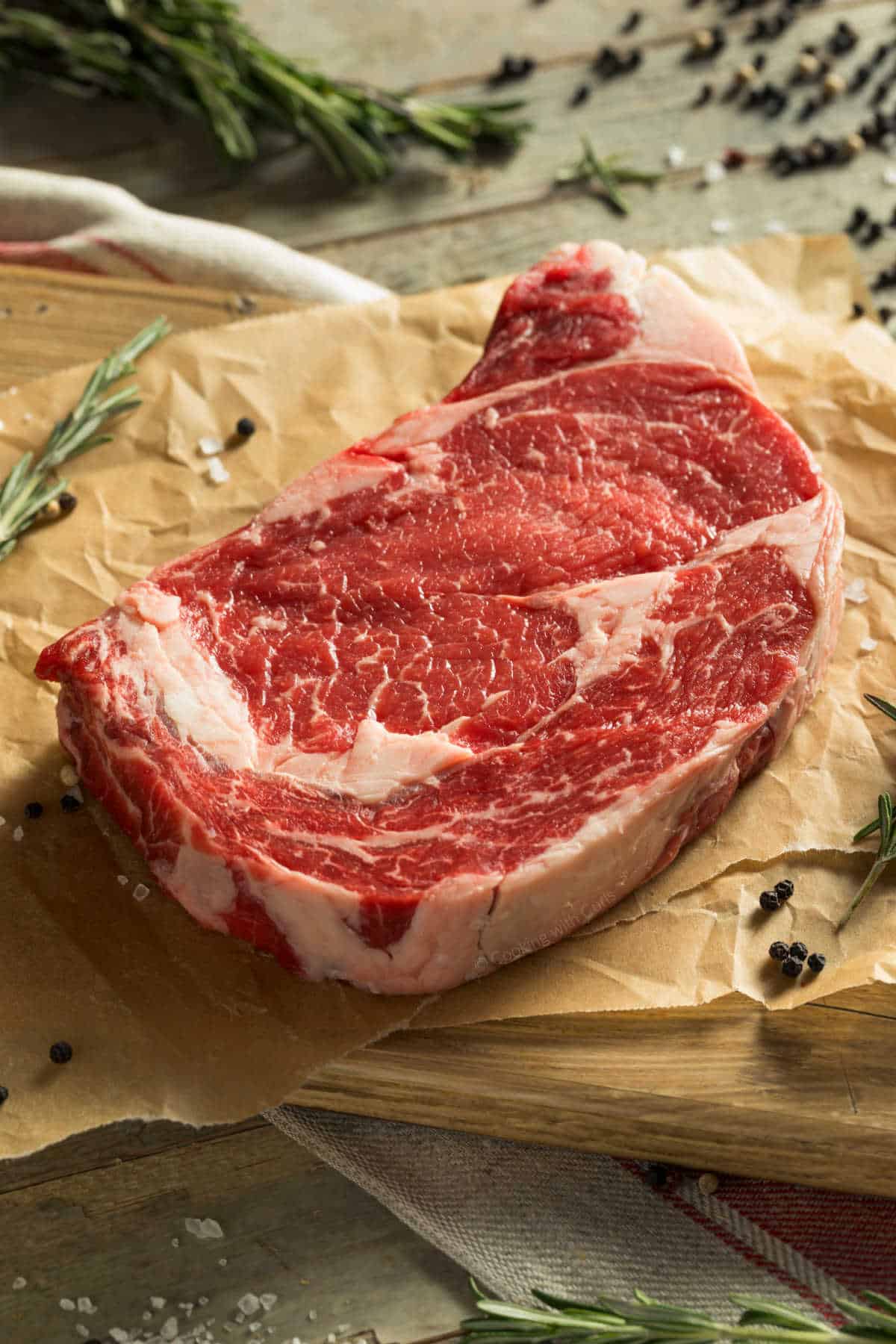
New York Strip (also known as Strip Steak or Kansas City Strip):
- Description: New York Strip steak is cut from the short loin of the cow. It’s characterized by a strip of fat along one edge and a firm texture.
- Characteristics: New York Strip has a bold, beefy flavor and a slightly firmer texture compared to ribeye. It’s less marbled than ribeye but still retains a good amount of tenderness and juiciness.
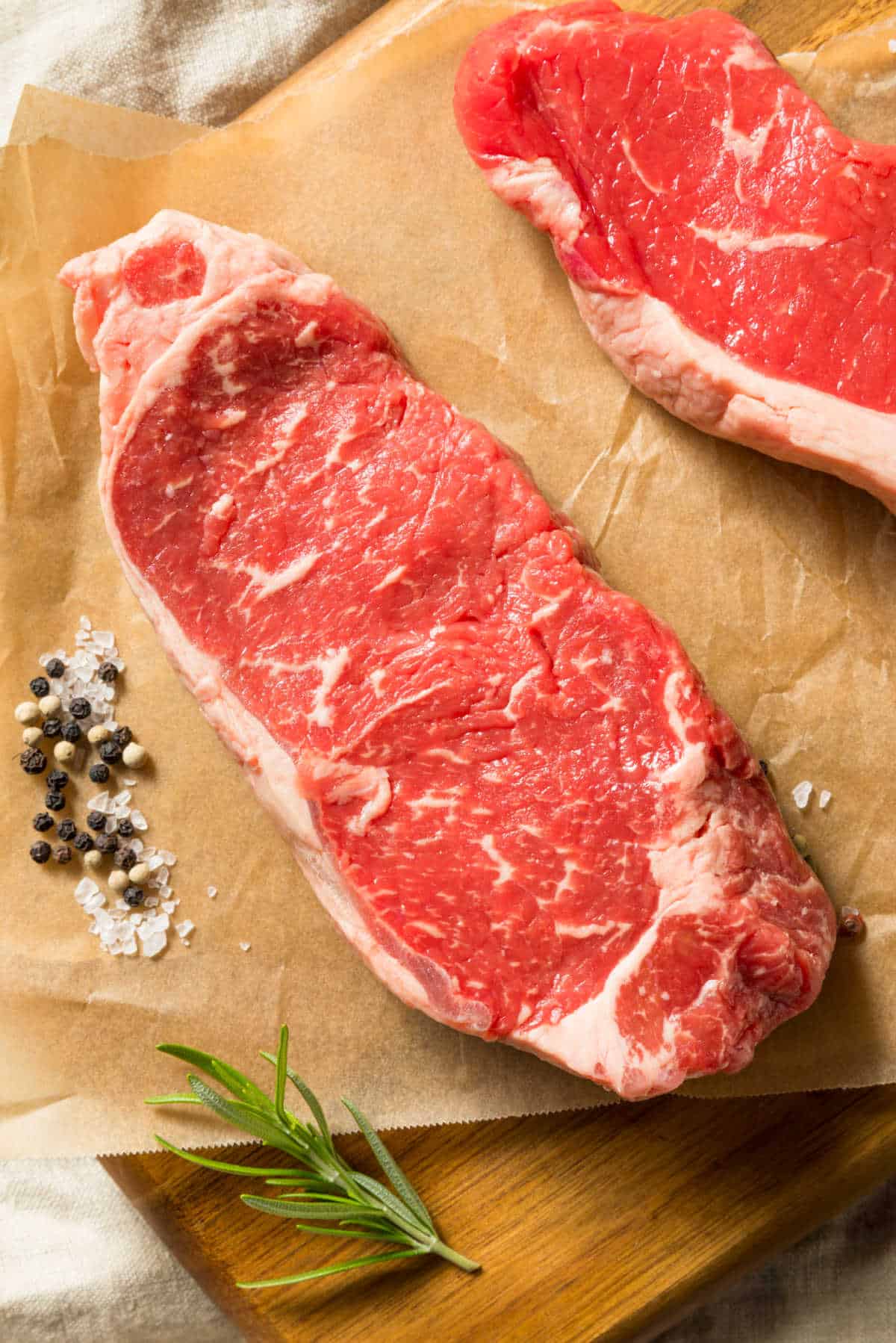
T-Bone:
- Description: T-Bone steak is named for the T-shaped bone it contains, which separates two cuts: the tenderloin and the strip loin (or New York Strip). It’s cut from the short loin primal.
- Characteristics: T-Bone offers the best of both worlds with a combination of tenderloin (filet mignon) and strip loin (New York Strip) in one cut. It’s known for its robust flavor and tender texture.
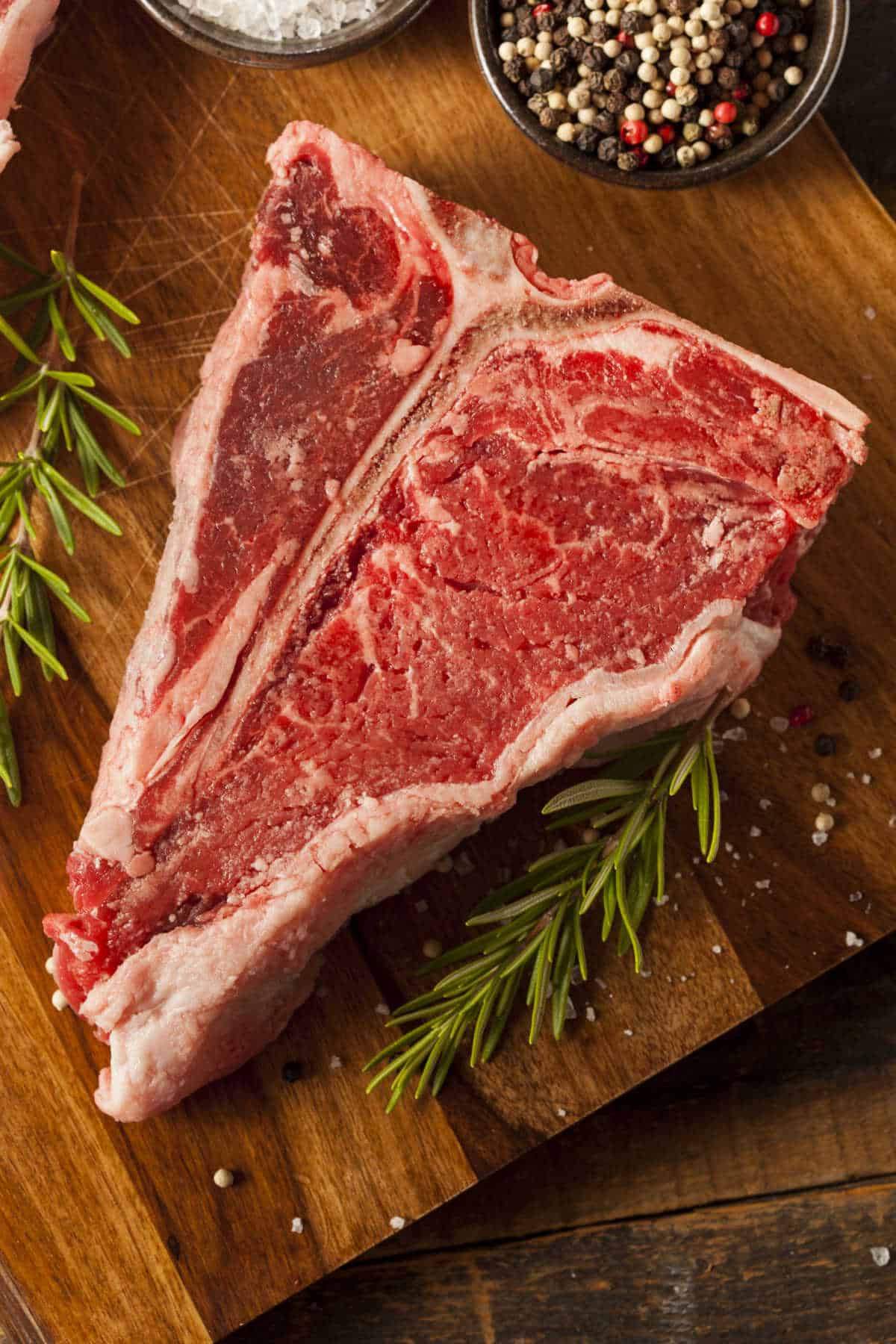
Porterhouse:
- Description: A porterhouse steak is essentially two steaks in one, featuring both the tenderloin (filet mignon) and the strip loin (New York strip) connected by a T-shaped bone. This unique combination offers the best of both worlds – tender, buttery meat from the tenderloin and bold, beefy flavor from the strip loin.
- Characteristics: Porterhouse steaks are typically large and thick, making them ideal for sharing or serving as a centerpiece for a special meal. The size can vary, but a true porterhouse steak is generally at least 1.25 inches thick.
Sirloin:
- Description: Sirloin steak is cut from the sirloin primal near the hip of the cow. It’s a versatile cut with good flavor and moderate tenderness.
- Characteristics: Sirloin steak has a firmer texture compared to cuts like ribeye or filet mignon. It’s leaner but still flavorful, making it suitable for grilling, broiling, or pan-searing.

Flank Steak:
- Description: Known for its intense beefy flavor, flank steak is cut from the abdominal muscles of the cow and is often used in dishes like fajitas and stir-fries.
- Characteristics: Because flank steak is lean and can be tougher compared to other cuts, it benefits greatly from marinating. Marinating helps tenderize the meat and infuse it with flavor.
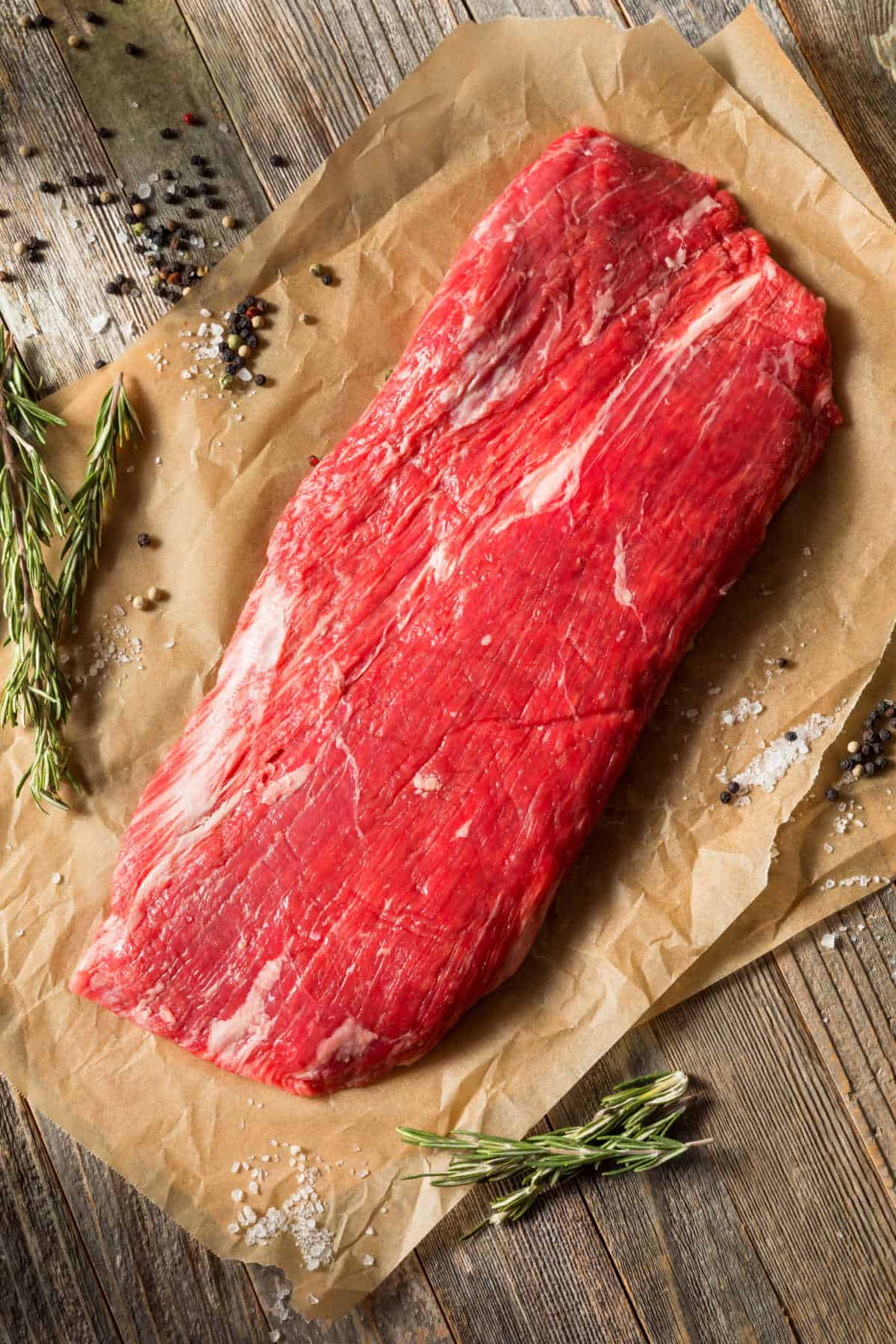
Skirt Steak:
- Description: Like flank steak, skirt steak comes from the abdominal muscles and has a robust flavor. It’s often used in dishes like carne asada tacos.
- Characteristics: Similar to flank steak, skirt steak is long and flat in shape, with a distinct grain that runs parallel to the length of the steak. This grain structure contributes to its characteristic texture and chewiness.
Flat Iron (also known as Top Blade Steak):
- Description: Flat Iron steak is cut from the shoulder of the cow, specifically from the top blade muscle. It’s known for its rich flavor and tenderness when cooked properly.
- Characteristics: Flat Iron steak has a good amount of marbling and connective tissue, which contributes to its tenderness and flavor. It’s often considered a more affordable alternative to cuts like ribeye or filet mignon while still offering excellent taste and texture.
Preparing and Seasoning the Steak
Preparing a steak before cooking is a crucial step that can significantly impact the final taste and texture of your meal. From choosing the right seasonings to understanding the impact of salting techniques, these aspects play a key role in the overall steak experience.
Thawing Frozen Steaks
Thawing steak properly is crucial to ensure safety, maintain quality, and achieve the best possible flavor and texture when cooked. Here are the recommended methods and key considerations for thawing frozen steak:
Refrigerator Thawing
Best for safety and quality
- Time Required: Depending on the size and cut of steak, thawing in the refrigerator can take anywhere from 12 to 24 hours. Larger or thicker cuts may require up to 48 hours.
- Procedure: Place the steak in its original packaging or a sealed container on a plate in the refrigerator. This method prevents cross-contamination and minimizes the risk of bacterial growth by keeping the steak at a safe, constant temperature.
- Considerations: This is the slowest thawing method but the safest and most recommended as it keeps the steak at a consistent, cold temperature, reducing the risk of bacteria
Cold Water Thawing
Faster than refrigerator thawing
- Time Required: Typically takes about 30 minutes per pound of steak.
- Procedure: Keep the steak in a leak-proof plastic bag to avoid water saturation and submerge it in cold water. Change the water every 30 minutes to ensure that it remains cold.
- Considerations: This method is faster than refrigerator thawing but requires more attention to changing the water frequently. Ensure that the bag is properly sealed to prevent water from seeping in and altering the texture of the meat.
Microwave Thawing
Fastest but least preferred method
- Time Required: Varies depending on the microwave setting and the size of the steak but generally takes a few minutes.
- Procedure: Use the ‘defrost’ setting on your microwave, typically setting the timer to 2-3 minutes per pound. Flip the steak halfway through the defrosting process to thaw evenly.
- Considerations: Microwave thawing can start cooking the edges of the steak if not monitored closely, leading to uneven cooking during the actual cooking process. Use this method only if you plan to cook the steak immediately after thawing.
Benefits of Bringing Steak to Room Temperature
- Even Cooking: When the steak starts at room temperature, it cooks more evenly throughout. A cold steak placed directly on heat can cook unevenly, resulting in an overcooked exterior and an undercooked interior.
- Faster Cooking Times: A steak that’s closer to room temperature will cook faster because it doesn’t require as much heat to reach the optimal cooking temperature. This can be particularly advantageous when trying to achieve a good sear on the outside while keeping the inside tender and juicy.
- Better Texture and Flavor: Allowing the steak to come to room temperature helps relax the muscle fibers, which can produce a tender texture. It can also enhance flavor development during cooking, particularly during the Maillard reaction, which is responsible for the delicious crust on a perfectly seared steak.
For the best results, planning your meals ahead and allowing the steak to thaw slowly in the refrigerator is recommended. This method preserves the texture and flavor integrity of the steak.
How to Bring Steak to Room Temperature Safely
- Timing: Depending on the thickness of the steak, it generally takes about 30 to 60 minutes for the steak to reach room temperature. Larger, thicker cuts might take longer.
- Safety Precautions: It’s important to manage this process carefully to prevent any food safety risks. Never leave steak unrefrigerated for more than two hours. In hot environments (above 90°F or 32°C), reduce this time to one hour to prevent bacterial growth.
- Preparation: Remove the steak from the refrigerator and place it on a plate or tray. Cover it lightly with plastic wrap or a clean cloth to avoid any contaminants.
- Check for Readiness: The steak should not feel cold to the touch; it should approximately match the ambient room temperature.
- Seasoning: Seasoning the steak just before cooking allows the salt and pepper to directly flavor the meat as it cooks. This ensures that the seasoning penetrates the surface of the steak and enhances its taste. Adding salt too early can draw out moisture from the meat, which may result in a drier texture.
Always consider food safety and be mindful of the overall kitchen environment to prevent any health risks associated with improper meat handling.
Post-Thawing Tips
- Pat Dry: After thawing, pat the steak dry with paper towels to remove excess moisture. This helps in achieving a better sear and crust during cooking, we do not want to steam the meat.
- Immediate Cooking: Once thawed, especially if using the microwave or cold water method, cook the steak immediately to prevent any bacterial growth.
- Check for Consistency: Feel the steak to ensure it has thawed completely. It should be uniform in texture without any icy or hard spots.
Seasoning Tips and Flavor Combinations
When it comes to seasoning your steak, simplicity can sometimes be ideal. A classic blend of kosher salt and black pepper can enhance the natural flavors of the meat without overpowering it.

If you’re looking to take your steak up a notch, consider experimenting with herb-infused rubs or Canadian steak marinade. Herbs like rosemary, thyme, or oregano can add an aromatic dimension to your steak, while marinades with soy sauce, garlic, or balsamic vinegar can introduce a tangy and savory note.
Lime juice, garlic, onion, and oil create the perfect marinade for my cilantro-lime steak salad.

Different spices and herbs can complement various types of steak cuts. For instance, a bold cafe mocha dry rub might work well with a rich ribeye, while a delicate marinade could enhance the tenderness of a filet mignon.
The key is to balance the flavors and avoid overwhelming the natural taste of the meat. Experiment with different combinations to find your perfect match.
Cooking Techniques for the Perfect Steak
Cooking a steak to perfection is an art that requires understanding different techniques. Let’s dive into the methods that will help you achieve that mouthwatering, juicy steak every time.
Steakhouse Method:
- Description: The steakhouse method involves cooking the steak over high heat, typically on a grill or a broiler, to achieve a flavorful sear on the outside while keeping the interior juicy and tender.
- Process: The steak is seasoned with salt and pepper, then cooked over high heat until it develops a nice crust on the outside while maintaining a medium-rare to medium doneness on the inside.
- Benefits: This method is straightforward and results in a well-seared exterior with a juicy and flavorful interior. It’s ideal for thicker cuts like ribeye or T-bone steak.
This steakhouse-quality grilled steak and shrimp is easy to prepare surf and turf meal that is on the table in about 30 minutes.
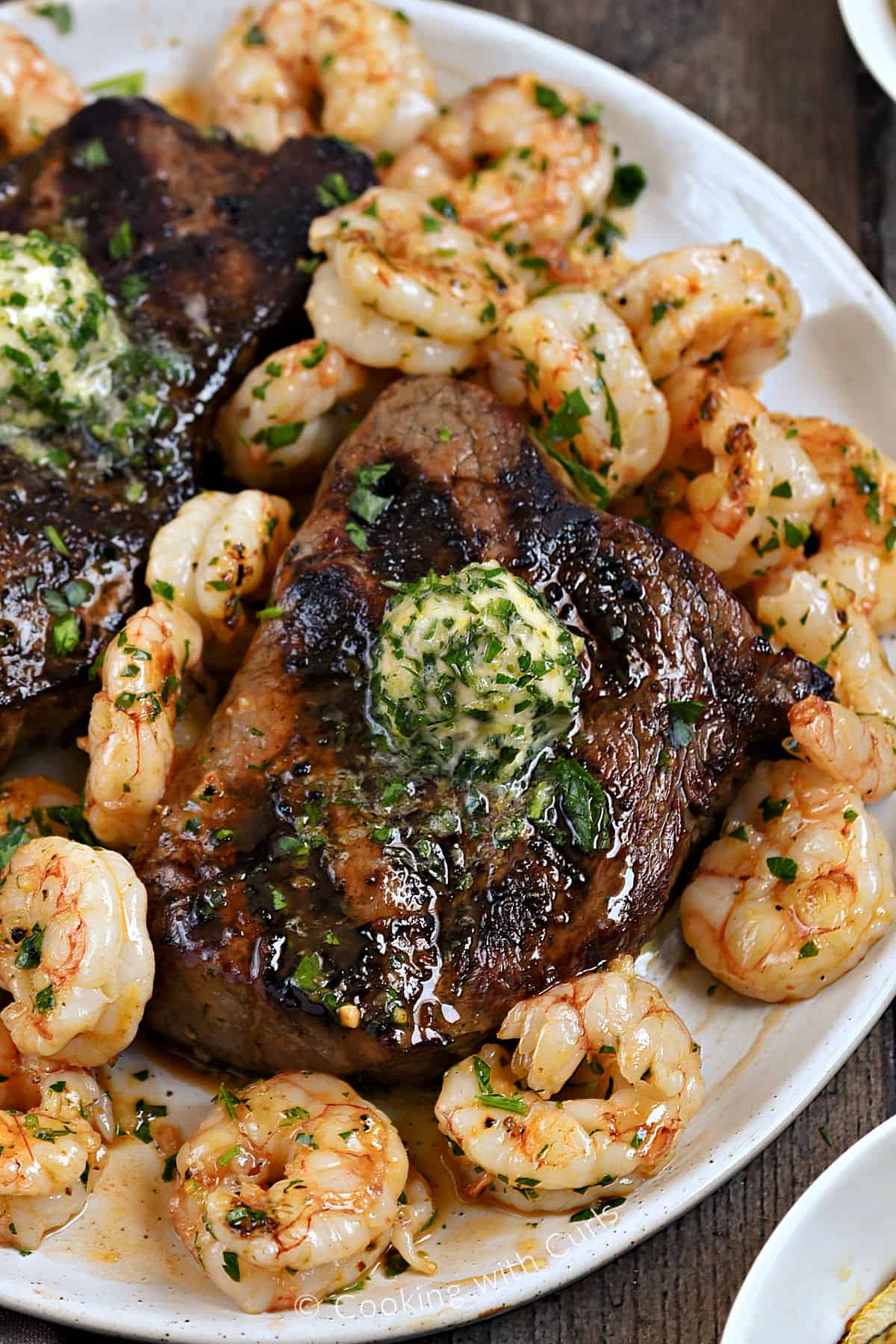
Searing:
- Description: Searing involves cooking the steak over high heat in a skillet or on a grill to create a flavorful crust on the outside while retaining the natural juices inside.
- Process: The steak is seasoned and then placed on a preheated skillet or grill, cooking for a few minutes on each side until a golden-brown crust forms. After searing, the steak may be finished in the oven to reach the desired level of doneness.
- Benefits: Searing locks in the juices and enhances the flavor by caramelizing the surface of the steak. It’s a versatile method suitable for various cuts and thicknesses.
Pan-searing is one of my favorite ways to prepare steak, like this classic peppercorn-crusted Steak au Poivre with creamy cognac sauce.

Reverse Sear:
- Description: The reverse sear method involves cooking the steak low and slow in the oven or on indirect heat before finishing it with a quick sear on high heat to develop a crust.
- Process: The steak is seasoned and then cooked in a low-temperature oven (around 275°F to 300°F) until it reaches an internal temperature close to the desired doneness. It’s then seared on a hot skillet or grill for a brief period to finish.
- Benefits: Reverse searing allows for precise control over the steak’s internal temperature, resulting in evenly cooked meat from edge to edge. It produces a beautifully seared crust while maintaining a tender and juicy interior, making it perfect for thicker cuts like filet mignon or ribeye.
Sous Vide:
- Description: Sous vide cooking involves vacuum-sealing the steak in a bag and cooking it in a water bath at a precise temperature for an extended period, then finishing with a quick sear.
- Process: The steak is seasoned and vacuum-sealed in a bag, then cooked in a water bath at a precise temperature determined by the desired level of doneness. After sous vide cooking, the steak is quickly seared on a hot skillet or grill to develop a nice crust.
- Benefits: Sous vide ensures precise temperature control, resulting in evenly cooked steak with edge-to-edge perfection. It also allows for convenience and flexibility as the steak can be cooked ahead of time and finished with a quick sear before serving.
If your Instant Pot has a sous-vide setting, you can make this melt-in-your-mouth Sous-Vide Filet Mignon (or any other steak) with very little effort.
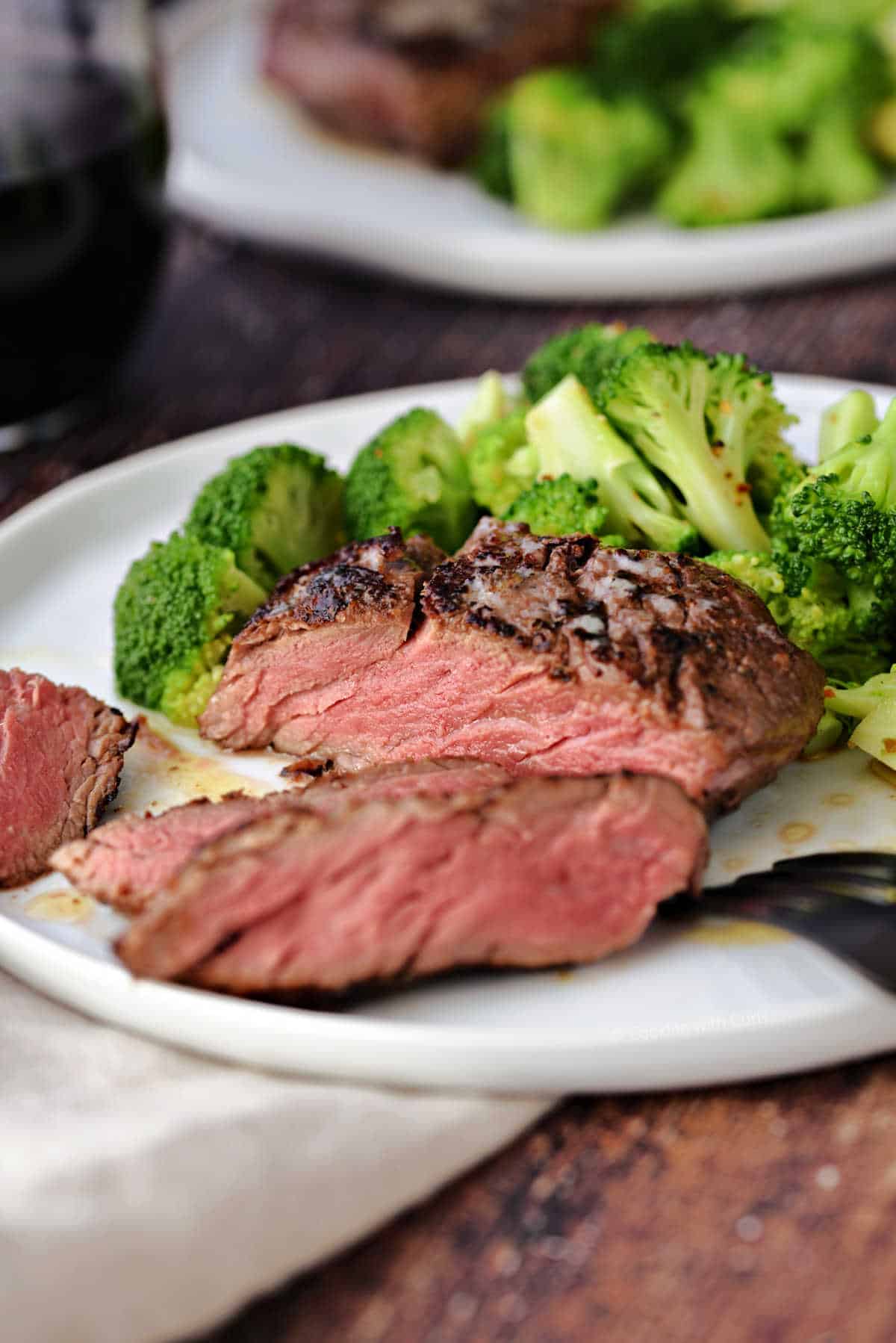
Direct Grilling:
- Description: Direct grilling involves cooking the steak directly over high heat on a grill, resulting in a charred exterior and juicy interior.
- Process: The steak is seasoned and placed directly over the heat source on the grill, cooking for a few minutes on each side until it reaches the desired level of doneness.
- Benefits: Direct grilling imparts a smoky flavor and creates those coveted grill marks, while maintaining a juicy and tender interior. It’s a classic and straightforward method suitable for various cuts and thicknesses, ideal for outdoor cooking.
- Cons: Grilling can sometimes dry out the steak if not monitored carefully.
This grilled sirloin steak is featured in my Steak Burritos with salsa Spanish rice.
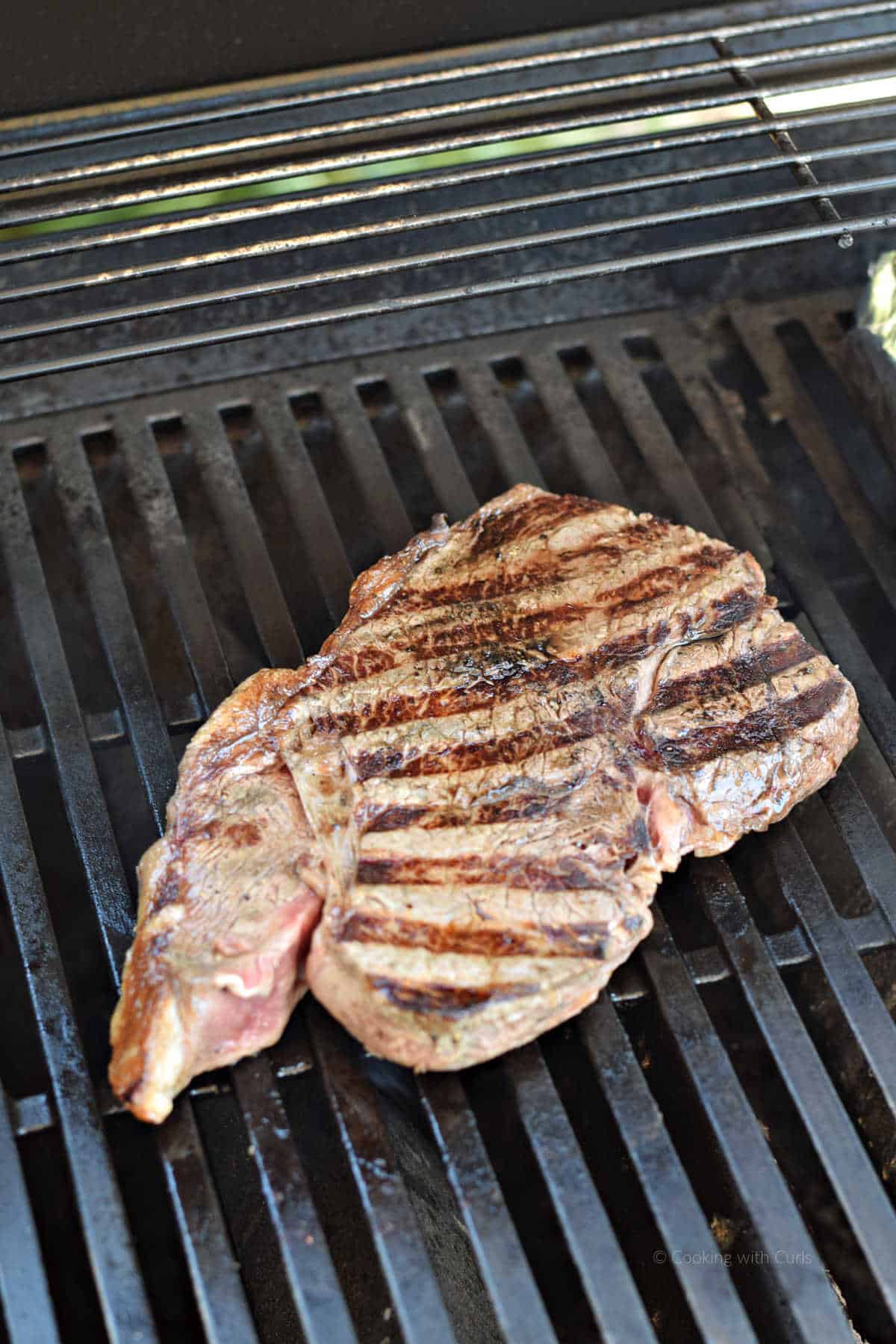
Air Fryer:
- Description: An air fryer uses hot air circulated at high speed to cook food, creating a golden-brown crust on the outside while keeping the inside tender and juicy.
- Process: Preheat your air fryer to the desired temperature, place the seasoned steak in the air fryer basket or on the air fryer tray in a single layer. Avoid overcrowding the basket to ensure proper air circulation.
- Benefits: Cooking steak in an air fryer is quick and convenient, with no need for preheating a grill or oven. Compared to traditional frying methods, air frying requires minimal oil, making it a healthier option for cooking steak.
This tender and juicy air fryer steak is perfect when you prefer to not heat up the kitchen or step outside when it is over 100 degrees.
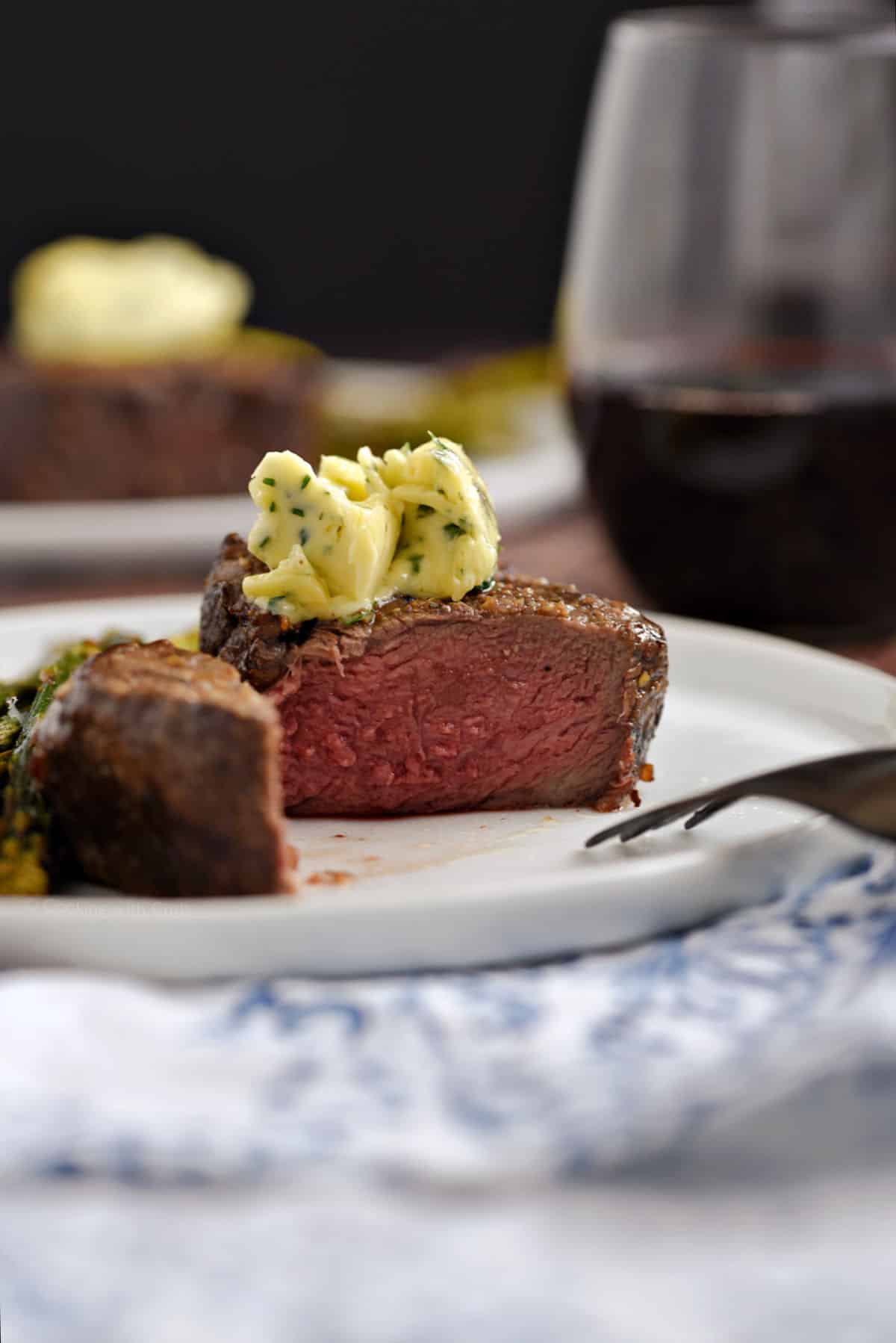
Achieving the Perfect Doneness
Achieving the ideal doneness of a steak is largely dependent on reaching specific internal temperatures during cooking. Using a meat thermometer to check the temperature ensures that your steak is cooked to your liking.
Here is a guide to the internal temperature ranges for different levels of steak doneness:
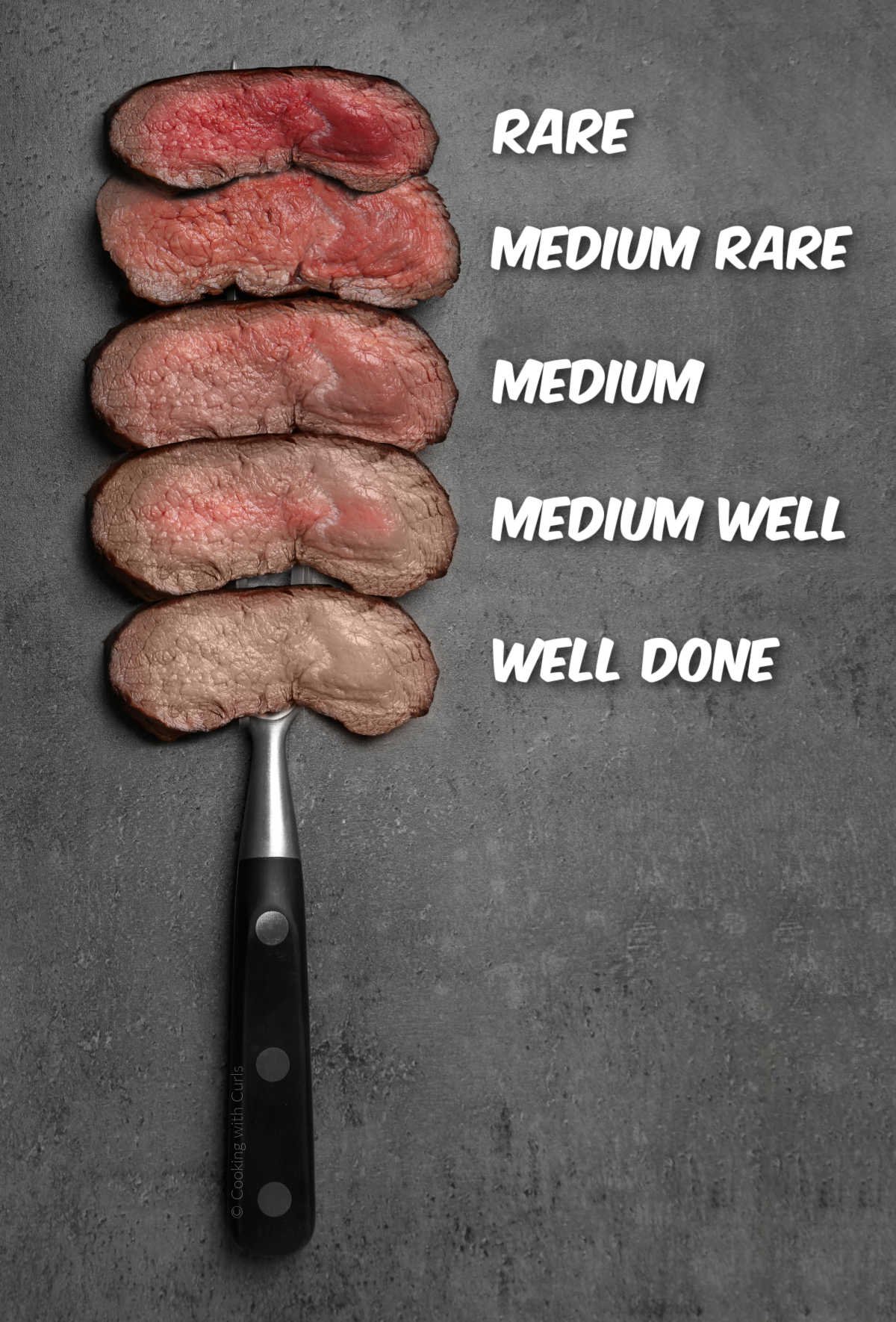
Steak Doneness Temperature Guide
- Rare: 120-125°F (49-52°C) – Characteristics: A cool red center, very soft to the touch.
- Medium Rare: 130-135°F (54-57°C) – Characteristics: A warm red center, with a slightly firmer texture than rare.
- Medium: 140-145°F (60-63°C) – Characteristics: A warm pink center, firmer to the touch with more resistance than medium rare.
- Medium Well: 150-155°F (65-68°C) – Characteristics: A slightly pink center, much firmer texture.
- Well Done: 160°F (71°C) and above – Characteristics: No pink at all, very firm, and with a tougher texture.
Tips for Accurate Temperature Measurement
- Use a Reliable Meat Thermometer: Invest in a good-quality instant-read thermometer for the most accurate results.
- Insert Correctly: Insert the thermometer into the thickest part of the steak, away from any fat or bone, which can skew the reading.
- Allow for Carryover Cooking: Remember that the steak will continue to cook (carryover cooking) for a few minutes after it is removed from the heat source. It’s advisable to remove the steak from the heat when it is 5°F lower than the desired final temperature.
- Rest the Steak: Let the steak rest for several minutes after cooking. This allows the juices to redistribute throughout the meat, resulting in a more tender and juicy steak. The internal temperature can rise by 5°F during this time, which should be considered especially for higher levels of doneness.
Achieving these levels of doneness requires adjusting your cooking techniques accordingly. For rare to medium-rare steaks, a quick sear or grill over high heat is ideal, while medium-well to well-done steaks benefit from longer cooking times at lower temperatures to prevent overcooking the exterior.
Experimenting with different cooking methods and temperatures will help you discover your favorite way to cook various steak cuts to achieve optimal flavor and tenderness.
Resting and Serving the Steak
After cooking your steak to the desired doneness, the resting period is essential to allow the juices to redistribute evenly throughout the meat, resulting in a more tender and flavorful steak.
Resting Periods Based on Cooking Method
- Grilling: For steaks cooked on the grill, such as ribeye or T-bone, a resting time of about 5-10 minutes is recommended. This allows the outer layers, which may have gotten a bit tough from the high heat, to relax and the juices to settle back into the meat.
- Pan-Searing: Steaks cooked on the stovetop benefit from a slightly longer resting period of 10-15 minutes. The residual heat continues to cook the steak during this time, while the juices redistribute, ensuring each bite is juicy and flavorful.
- Oven-Baking: When you bake your steak in the oven, like with a filet mignon, a resting time of 5-8 minutes is usually sufficient. This resting period helps retain the steak’s moisture, making it succulent and delicious.
Remember, the resting period is as crucial as the cooking process itself. Rushing to slice into your steak immediately after cooking can result in the juices running out onto the plate, leaving the meat dry. Be patient and allow your steak to rest for the recommended time to achieve the best possible flavors and textures.
Side Dishes and Wine Pairings
Savoring a perfectly cooked steak is an amazing experience, but the right side dish and wine that complements your steak can take your meal to a whole new level.
Choosing the Right Side Dishes
When it comes to choosing the ideal side dish for your steak, the options are endless. Traditional steakhouse sides like crispy baked potatoes, creamy mashed potatoes, roasted broccoli, or a crisp garden salad are always a great choice.
For a fun twist, think outside the box and serve roasted Brussels sprouts with balsamic glaze, mac and cheese, or a mixed greens, berries, and avocado salad.
To create a well-rounded meal, think about balancing flavors and textures. If your steak is rich and savory, opt for a lighter side dish like a fresh citrus salad to cleanse the palate. If your steak is lean with a more subtle flavor, a creamy potato gratin or buttery mushrooms can add a touch of decadence.
Don’t be afraid to mix and match to find the perfect combination that suits your taste buds.
Choosing the Right Wine to Enhance the Steak
Pairing steak with the right wine can add to your overall dining experience. Red wines are the classic choice to complement the richness of steak.
- Cabernet Sauvignon: Cabernet Sauvignon is a bold and full-bodied red wine with flavors of dark fruits, such as blackberry and plum, along with notes of cedar, tobacco, and vanilla. Its robust tannins and acidity make it an excellent match for rich, fatty cuts of steak like ribeye or porterhouse.
- Malbec: Malbec is a medium to full-bodied red wine with ripe fruit flavors of blackberry, plum, and cherry, along with hints of spice and chocolate. Its smooth tannins and acidity pair well with grilled or seared steaks, particularly those with smoky or charred flavors.
- Merlot: Merlot is a medium-bodied red wine with soft tannins and flavors of plum, cherry, and red currant, as well as hints of earth and herbs. Its smooth texture and fruit-forward profile make it a versatile choice for various cuts of steak, including filet mignon and sirloin.
- Syrah/Shiraz: Syrah/Shiraz is a full-bodied red wine with bold flavors of blackberry, blueberry, pepper, and smoked meat, along with hints of spice and herbs. Its intensity and structure complement hearty cuts of steak like ribeye or T-bone, especially when grilled or barbecued.
- Zinfandel: Zinfandel is a medium to full-bodied red wine with jammy fruit flavors of raspberry, blackberry, and cherry, along with hints of spice and pepper. Its bold fruitiness and moderate tannins pair well with grilled or barbecued steaks, adding a touch of sweetness to the meal.
- Cabernet Franc: Cabernet Franc is a medium to full-bodied red wine with flavors of red fruits, green bell pepper, and herbs, as well as earthy undertones. Its vibrant acidity and herbal notes make it a great match for leaner cuts of steak like flank or skirt steak, as well as dishes with herbaceous sauces or marinades.
- Chianti: Chianti is a medium-bodied red wine from Tuscany, Italy, with flavors of cherry, plum, and dried herbs, along with bright acidity and firm tannins. Its acidity and versatility make it a classic pairing for grilled or roasted steaks, particularly those seasoned with herbs or served with tomato-based sauces.
- Pinot Noir: Pinot Noir is a lighter-bodied red wind that offers flavors of red berries, cherry, and earthy notes, along with silky tannins and vibrant acidity. Its versatility and elegance make it a great match for a variety of steak dishes, from grilled to pan-seared.
The key to a successful pairing is to match the characteristics of the wine with the flavors of the steak. The boldness of a Cabernet Sauvignon can stand up to a perfectly seared ribeye, while combination of the tender, buttery meat of the filet mignon with the fruity, elegant characteristics of Pinot Noir can create a luxurious dining experience.
Experiment with different wines and steak cuts to discover your favorite combinations that create the perfect meal for you and your family.
Decisions, Decisions
When cooking steak, budget and personal preferences play significant roles. Here are some things to consider that can help you make informed decisions while accommodating budget constraints and personal tastes:
Budget-Friendly Cuts of Steak
Not all steaks are created equal, especially when it comes to price. If you’re looking to enjoy a steak dinner without breaking the bank, consider opting for less expensive cuts that still offer good flavor and texture:
- Chuck Steak: Often more affordable, chuck steak can be tenderized through marinating or slow cooking methods.
- Skirt Steak: Known for its flavor, skirt steak is cheaper than premium cuts and is ideal for quick searing.
- Flat Iron Steak: A great combination of tenderness and rich flavor, flat iron is relatively inexpensive compared to high-end cuts. Investing in a good meat tenderizer or marinade can enhance these less costly cuts, making them a worthwhile option for budget-conscious steak lovers.
Personal Preference
Taste, texture, and personal preference is key when selecting steak, as each cut offers distinct flavors and textures:
- Flavor Intensity: For those who enjoy rich, bold flavors, fattier cuts like ribeye or porterhouse provide a robust taste. Leaner cuts like sirloin or filet mignon offer a more subtle flavor.
- Texture Preference: Tender cuts like filet mignon are preferred by those who enjoy a buttery texture. Cuts like flank or hanger steak have a firmer texture suitable for those who appreciate a chewier bite.
Keep an eye on your local grocery store ads and emails, you may be able to find some awesome deals on your favorite steaks that you can purchase and store in the freezer until ready to enjoy.
Cooking Method Based on Preference
The choice of cooking method can significantly impact the flavor and texture of the steak, thus aligning with personal preferences:
- Grilling: Ideal for those who prefer a smoky flavor and enjoy the traditional charred texture of grilled meats.
- Pan-Searing: Best for achieving a caramelized crust with a juicy interior, perfect for enhancing the natural flavors of the steak.
- Broiling: A suitable method for quicker cooking, ideal for thinner cuts or for those preferring a less fatty cooking process.
Accommodations for Dietary Restrictions
For individuals with dietary restrictions, consider alternative preparation methods or ingredient substitutions:
- Low-Sodium: Reduce salt in marinades and seasonings, or use salt substitutes to accommodate low-sodium diets.
- Low-Fat: Choose leaner cuts such as sirloin tip or top round to limit fat intake, and use cooking methods like broiling, baking, or air fryer that require less added fat.
Experimentation with different cuts, seasonings, and cooking methods can lead to discovering new preferences and expanding culinary skills.
Trying lesser-known cuts or experimenting with global flavor profiles (like Asian-inspired marinades or Mediterranean herbs) can transform the steak experience while respecting both budget and personal tastes.
More Delicious Steak Recipes
- Grilled Steak Fajita Skewers with Chimichurri – Juicy, tender steak strips marinated in a flavorful blend of spices, threaded onto skewers with colorful bell peppers and onions, then grilled to perfection.
- Korean BBQ Steak Tips – Asian-flavored marinade, cooked in a cast iron skillet and served with fresh vegetables.
- Steak Marsala – Pan-seared steaks topped with a marsala infused mushroom sauce.
- Sirloin Chimichurri Steak – Grilled steaks topped with a flavorful Argentinian herb sauce.
- Hibachi Steak and Salmon – Marinated and grilled to perfection on a cast iron skillet.
- Steak Oscar – Perfectly cooked steak topped with crab and a rich and creamy Béarnaise sauce.
- Pub-Style Steak – Marinated in beer and topped with caramelized shallots and a garlic-herb compound butter.
Did you enjoy this post? I’d love to see what you create!
Tag @cookingwithcurls on Instagram & Facebook and leave a ⭐️⭐⭐⭐⭐ review below!
Enjoy!!

